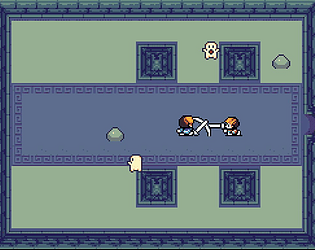Thanks for playing! :)
dotmos
Creator of
Recent community posts
:D
Yeah well "tech demo" might have been misleading on my part. :)
I should have just called it demo (and even that would be problematic on C64 :D ). For me tech demo was meant as a way to say "Look, this is far from finished, there are bugs, it is rough around the edges but at least it won't set your PC on fire (i hope)" :D
By now i absolutely get why some people are misled by that and that it can mean something completly different per platform. Especially the Amiga version caused some big question marks above people's heads. (and some good laughs :D )
Thanks for playing till the end, and for your other feedback post too! Much appreciated :)
Hey!
Thanks a lot for your feedback! :)
I tried the C64, Amiga and Dos versions on real hardware and they work for me.
I have not yet tried the Megadrive version on a real Megadrive, since mine is broken and i did not yet have the time to fix it. Please let me know, if it works for you :)
As for the Atari ST version: This is VERY interesting. I have not yet managed to get it working on my ST 1040, nor on my Mega ST 2. I was not sure if it was due to me being stupid, faulty disks or bad coding. Because of your report i am now 99.9% sure it is due to bad coding and will have a look at it once i have the time.
Thanks again for letting me know and thanks for playing! :)
Really nice collection of portraits! I was a tiny bit sceptical at first, but this is well worth the money! :)
It would be awesome if you could create some more portraits, to be a perfect fit for your "sprites battlers pack". Portraits of werewolves, imps/demons, soldiers and some more zombies would be awesome.
Thanks!
Hi! :)
The C64 version of Space Cavern Blaster currently only supports standard one-button joysticks. I always thought it was not possible to use more, but your question made me search the internet again and you are right: there are methods to use 2-3 button joysticks/gamepads on a C64.
While two-button sticks are not the norm on a C64, i really like the idea and added two button support to my to-do list.
Thanks for the hint! :)
[Edit] For now, you have to press "Up" to jump in the C64 version.
Hi! :)
The game requires a horizontal resolution of at least 320 pixels. Amstrad/Schneider CPC has a horizontal resolution of 160 pixels if more colors are used.
Since the C64 version also uses 160 pixels, I think it might actually be possible to port the game to the Amstrad without too much hassle.
I have it on my list, but I haven't done enough research on the Amstrad machines to be sure if it's really feasible (i guess it is). I'm sorry, I can't give you a definitive answer right now, but rest assured: I WILL try it! :)
Hi! :)
The game requires a horizontal resolution of at least 320 pixels. The NES has a resolution of 256 pixels.
I'm still thinking about how to port it to PCs/consoles that have a lower resolution without too much hassle. Scrolling is an option and probably the way to go. Once i'm happy with my solution, i'll definitely try my best to port it to the NES, SNES and Mastersystem! :)
Hi,
The engine was written from scratch for the jam. There are platform specific implementations for rendering, input, audio and timing. The gamecode itself is platform-agnostic. During the build process, the correct target platform implementations for rendering/input/audio/timing are selected and used.
Amiga uses 4bpp interleaved bitplanes and blitter driven software sprites for rendering. Audio is implemented via the awesome "ptplayer.asm" by Frank Wille. I still have to create an automated workflow to create an .adf file after compilation is done.
Atari ST uses regular 4bpp bitplanes. No blitter is used, as i wanted to be compatible with regular, non STe Ataris. This slows rendering down a lot, but at the moment it's good enough. Digital SFX is implemented via "interrupt bashing" the ym2149. Playing music is not yet possible. After compilation is done, everything is automatically wrapped up and put in an .st file using "MSAConverter".
DOS uses "god old" mode 13h for rendering. I also tried ModeX/unchained mode, but it was not worth it in my case. Audio is implemented via "MikMod".
All images are regular 8bpp and are converted to the target platform format during the build process via Image Magick/Irfan View scripts.
Audio is converted to target platform format with SoX scripts.
Maps are created in "Tiled", exported to json and then converted to a custom raw format to be used in the game.
The engine is written in C and a very very tiny bit of (inline) ASM.
Implementing all these things took way too long, but it was a lot of fun and I will definitely keep working on the engine and implement more target platforms :)



